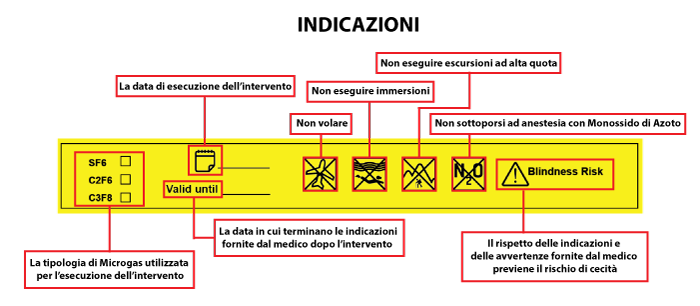MICROGAS
WARNINGS

General description of the device
Microgases are high-molecular-weight gases intended to replace the vitreous humor, present in the eyeball, in surgeries in which the eyeball must be removed.
In less complicated cases the vitreous is not replaced, while at other times it must be replaced with a so-called “vitreous substitute.”
After surgery, Microgases remain inside the eye for different times depending on the gas used: SF6 1-2 weeks, C2F6 4-5 weeks, C3F8 6-8 weeks.
The device should only be used in sterile field by professionals.

Contraindications
The main contraindications are for use by health care providers.
Patients who have undergone Microgas surgery must strictly adhere to the instructions they were given at the hospital. They must also keep the implantable card and show it whenever they go to the hospital, they must notify the anesthesiologist immediately if they have to undergo anesthesia, local or general.
He must also wear the patient bracelet on his wrist at all times, which lists the main correct behaviors to be followed, such as avoiding pressure surges, as in the case of air travel, scuba diving, hiking in the mountains, excessive exertion and temperature changes.
Risks and Warnings
You should contact your doctor if you believe you are experiencing side effects related to the device or if you are concerned about the risks. The purpose of this document is not to replace a consultation with your physician.
Follow the advice and precautions given to you at the hospital. Never stop treatment unless the surgeon says so; they help the operated eye heal better and prevent complications.
- Hold the head in the position indicated by the doctor. Do not rub the operated eye at all.
- Have all periodic checkups set by your doctor. Even after healing, the eye should be checked periodically by the ophthalmologist.
- Failure to take proper care, dressings, and postoperative checkups can jeopardize the success of the surgery.
- Always carry the implantable tag given to you and show it to the medical staff when you go to the hospital. In case of general anesthesia, whatever the reason, the presence of the gas bubble in the eye should be reported to the anesthesiologist.
- See your doctor immediately if you experience symptoms other than those described by your doctor.
The bracelet provided to you has symbols necessary to identify the presence of Microgas throughout your recovery and to remind you of behaviors to avoid, so do not remove it until your doctor confirms that the gas bubble in your eye has been reabsorbed. The completion of the bracelet is done by the physician who performed the procedure. The symbols shown on the bracelet indicate:

